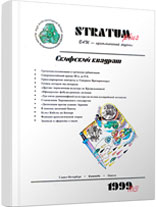Змеи и драконы. О продолжении одной античной традиции в ювелирном деле эпохи средневековья
Snakes and dragons. About the continuation of one antique tradition in the jewelry craft in the Middle Ages
Author(s): Svetlana S. RyabtsevaSubject(s): History, Archaeology, Cultural history, Visual Arts, Ancient World, Middle Ages, 6th to 12th Centuries
Published by: Издательский дом Stratum, Университет «Высшая антропологическая школа»
Summary/Abstract: Appeared in the antique period the tradition of decoration of bracelets, torque’s and chains by the snake’s heads didn’t lose its popularity in the Middle Ages. This phenomenon can be explained both by the stability of the classical tradition in the jewelry craft and by the semantic load of images of snake and dragon in the world outlook and folklore of many peoples. The decorating suitability of these images for ornamenting torque’s and bracelets is also important. In the ancient period there were distinguished some basic jewelry schools that used there images for decorating jewelry articles. The articles of these schools are different in form and in iconography of representations. Starting with VI c. B. C. various torque’s and bracelets with snakes’ and dragons’ heads were made by Thracians. Scythians also made bracelets, decorated with snakes’ heads, and on the early stage they seemed to be oriented to Thracian images. In the later period Scythian and Sarmatian fashion is influenced by Greek single- and multi spiral bracelets with snakes’ heads, spread in the Black Sea region in III c. B.C. – III c. A. D. At the end of the first millenium B. C. – beginning of the first millenium A. D. plaited neck chains, ended with snakes’ heads are wide spread. Various bracelets and torque´s with snakes’ and dragons’ heads get the greatest spreading in the end of IV-V c. A. D. among Germans, certain articles are found among Huns as well. Later in the course of some centuries on the territory of Eastern Europe this kind of decoration loses its popularity. And it appears again already in X-XI c., probably in the result of cultural contacts with the countries of Baltic region and Northern Europe.
Journal: Stratum plus. Археология и культурная антропология
- Issue Year: 1999
- Issue No: 3
- Page Range: 228-240
- Page Count: 13
- Language: Russian

